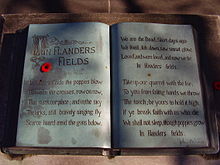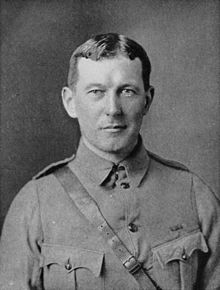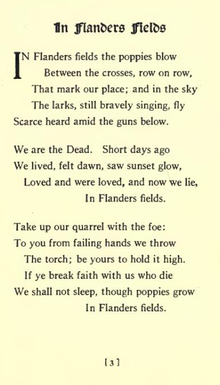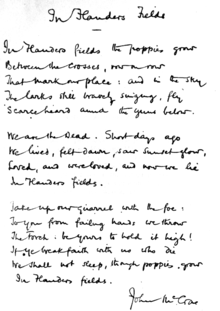在法蘭德斯戰場
| 此條目的语调或风格或許不合百科全書。 (2010年11月12日) |


在法兰德斯战场(英語:In Flanders Fields)是在第一次世界大戰其间的最重要的詩作之一,也被认为是那个时期最流行的诗[1]。这首法文回旋诗体的英文詩是加拿大的軍醫约翰·麦克雷(John McCrae)中校在目睹了他的年仅22岁的战友Alexis Helmer中尉的死,于第二天1915年5月3日所作,同年12月,发表在英国伦敦的双周刊Punch上。
法蘭德斯是第一次世界大戰最慘烈的戰場,德國欲封鎖法國加莱,於是德軍在1914年10月和比利時、法國軍隊在這裡開戰,雙方死亡慘重,而比利時盛開著虞美人花。因为这首詩,虞美人花成为全球國殤紀念日佩花。

原詩
1919年麥克雷的作品集“法蘭德斯戰場及其他詩歌”的第一章,裡面的這首詩的原文如下:[2]
In Flanders fields the poppies blow
Between the crosses, row on row,
That mark our place; and in the sky
The larks, still bravely singing, fly
Scarce heard amid the guns below.
We are the Dead. Short days ago
We lived, felt dawn, saw sunset glow,
Loved and were loved, and now we lie,
In Flanders fields.
Take up our quarrel with the foe:
To you from failing hands we throw
The torch; be yours to hold it high.
If ye break faith with us who die
We shall not sleep, though poppies grow
In Flanders fields.
翻译

在法兰德斯战场 虞美人迎风开放
开放在十字架之间,一排排一行行
标示我们断魂的地方
云雀依旧高歌,展翅在蓝蓝的天上
可你却难以听见,因为战场上枪炮正响
我们死去了,就在几天前
我们曾经拥有生命,沐浴曙光又见璀璨夕阳
我们爱人也为人所爱,可现在却安息在
法兰德斯战场
继续和敌人战斗吧
颤抖的双手抛给你们
那熊熊的火炬,让你们将它高举
你们若辜负死去的我们
我们将不会安息,尽管虞美人
盛開法兰德斯战场
參見
注释
- ^ Paul Fussell, The Great War and Modern Memory, Oxford University Press, 2000, p. 248.
- ^ In Flanders Fields and Other Poems. G. P. Putnam's Sons. 1919: 3. The typeset version of the poem ends the first line with "blow". The same book also includes McCrae's handwritten copy of the poem, in which the first line ends with "grow".
參考文獻
- Bassett, John, The Canadians: John McCrae, Markham, Ontario: Fitzhenry & Whiteside Limited, 1984, ISBN 0-88902-651-3
- Fussell, Paul, The Great War and Modern Memory (Illustrated Edition), New York: Stirling Publishing, 2009 [1975], ISBN 0-19-513331-5
- Gillmor, Don, Canada: A People's History two, Toronto, Ontario: McClelland & Stewart, 2001, ISBN 0-7710-3340-0, ISBN 0-7710-3341-9
- McCrae, John, In Flanders Fields and Other Poems, Arcturus Publishing (reprint 2008), 1919 [2012-02-07], ISBN 1-84193-994-3, (原始内容存档于2014-01-01)
- Prescott, John F., In Flanders Fields: The Story of John McCrae, Erin, Ontario: Boston Mills Press, 1985, ISBN 0-919783-07-4
外部連結
- Royal Canadian Legion web page about John McCrae, In Flanders Fields, and the custom of wearing poppies
- In Flanders Fields(页面存档备份,存于互联网档案馆), choral piece by composer Bradley Nelson, commissioned by Fresno State Chamber Singers and Chico State Chamber Singers of California State University
- In Flander's fields by Lt. Col. John McCrae, M.D. and America's answer by R. W. Lillard, 1914-1918(页面存档备份,存于互联网档案馆). Hamilton, Ont. : Commercial Engravers, 1918. 8 p. Accessed 4 January 2014, in PDF format.
 LibriVox中的公有领域有声书《In Flanders Fields》
LibriVox中的公有领域有声书《In Flanders Fields》
| |||||||||||||||||
